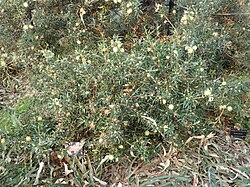Biology:Banksia obovata
| Wedge-leaved dryandra | |
|---|---|

| |
| Banksia obovata in the ANBG | |
| Scientific classification | |
| Kingdom: | Plantae |
| Clade: | Tracheophytes |
| Clade: | Angiosperms |
| Clade: | Eudicots |
| Order: | Proteales |
| Family: | Proteaceae |
| Genus: | Banksia |
| Subgenus: | Banksia subg. Banksia |
| Series: | Banksia ser. Dryandra |
| Species: | B. obovata
|
| Binomial name | |
| Banksia obovata A.R.Mast and K.R.Thiele[1]
| |
| Synonyms[1] | |
| |
Banksia obovata, commonly known as wedge-leaved dryandra,[2] is a species of shrub that is endemic to Western Australia. It has hairy stems, serrated, wedge-shaped to egg-shaped leaves with the lower end towards the base, cream-coloured or pale yellow flowers in heads of up to 100, and egg-shaped follicles. It is found in near-coastal areas in the south of the state.
Description
Banksia obovata is a shrub that typically grows to a height of 2 m (6 ft 7 in) but does not form a lignotuber. It has wedge-shaped to egg-shaped leaves with the narrower end at the base, 25–65 mm (0.98–2.56 in) long and 10–30 mm (0.39–1.18 in) wide on a petiole up to 15 mm (0.59 in) long, with between four and twelve serrations on each side. Between thirty-five and one hundred cream-coloured or pale yellow flowers are borne in a head with linear to egg-shaped involucral bracts up to 12 mm (0.47 in) long at the base of the head. The perianth is 23–38 mm (0.91–1.50 in) long and the pistil 24–40 mm (0.94–1.57 in) long. Flowering occurs mainly occurs from April to November, but also in other months and the follicles are egg-shaped, 10–14 mm (0.39–0.55 in) long.[2][3]
Taxonomy and naming
This species was first formally described in 1810 by Robert Brown in Transactions of the Linnean Society of London and was given the name Dryandra cuneata.[4][5] The specific epithet (cuneata) is a Latin word meaning wedge-shaped.[6]:174
In 2007, Austin Mast and Kevin Thiele transferred all dryandras to the genus Banksia.[7][8] As there was already a plant named Banksia cuneata (matchstick banksia), Mast and Thiele chose the epithet obovata, meaning "inverted egg-shaped, in reference to the obovate leaves.[6]:263
Distribution and habitat
Wedge-leaved dryandra occurs near the south coast of Western Australia between Narrogin, Albany and the Cape Arid National Park, including in the Stirling Range. It grows in kwongan.[2][3]
References
- ↑ 1.0 1.1 "Banksia obovata". https://biodiversity.org.au/nsl/services/apc-format/display/204997.
- ↑ 2.0 2.1 2.2 "Banksia obovata". FloraBase. Western Australian Government Department of Parks and Wildlife. https://florabase.dpaw.wa.gov.au/browse/profile/32198.
- ↑ 3.0 3.1 George, Alex S. (1999). Flora of Australia. 17B. Canberra: Australian Biological Resources Study, Canberra. pp. 267–268. https://www.environment.gov.au/system/files/pages/6d8c5c3b-8545-437e-b9b3-944ac95ee07a/files/flora-australia-17b-proteaceae-3-hakea-dryandra.pdf. Retrieved 19 May 2020.
- ↑ "Dryandra cuneata". APNI. https://id.biodiversity.org.au/instance/apni/527234.
- ↑ Brown, Robert (1810). "On the Proteaceae of Jussieu.". Transactions of the Linnean Society of London 10 (1): 212. https://www.biodiversitylibrary.org/item/46585#page/238/mode/1up. Retrieved 19 May 2020.
- ↑ 6.0 6.1 Francis Aubie Sharr (2019). Western Australian Plant Names and their Meanings. Kardinya, Western Australia: Four Gables Press. ISBN 9780958034180.
- ↑ Mast, Austin R.; Thiele, Kevin (2007). "The transfer of Dryandra R.Br. to Banksia L.f. (Proteaceae)". Australian Systematic Botany 20 (1): 63–71. doi:10.1071/SB06016.
- ↑ "Banksia kippistiana". APNI. https://id.biodiversity.org.au/instance/apni/614282.
- Cavanagh, Tony and Margaret Pieroni (2006). The Dryandras. Melbourne: Australian Plants Society (SGAP Victoria); Perth: Wildflower Society of Western Australia. ISBN 1-876473-54-1.
Wikidata ☰ Q51042904 entry
 |


